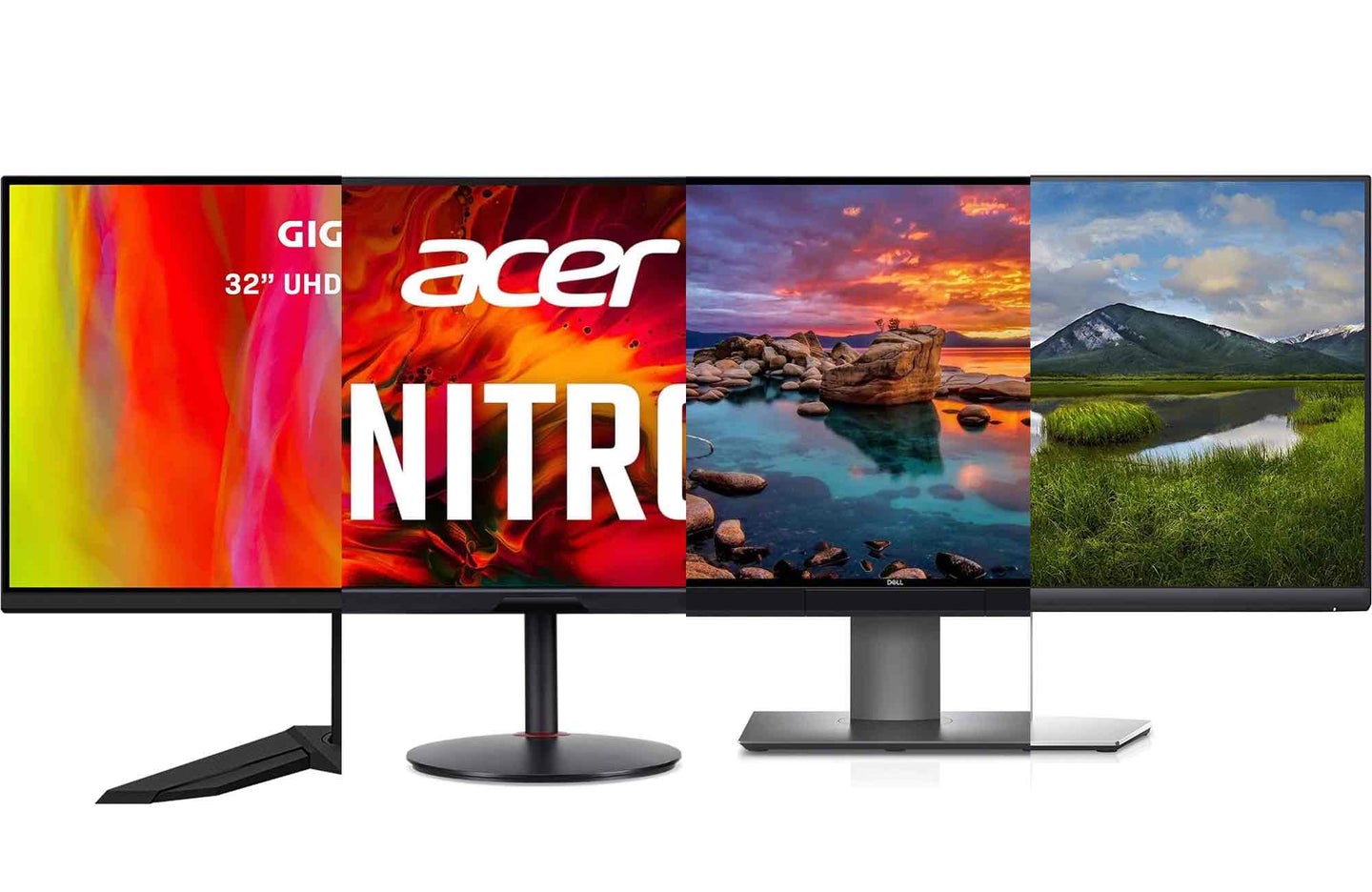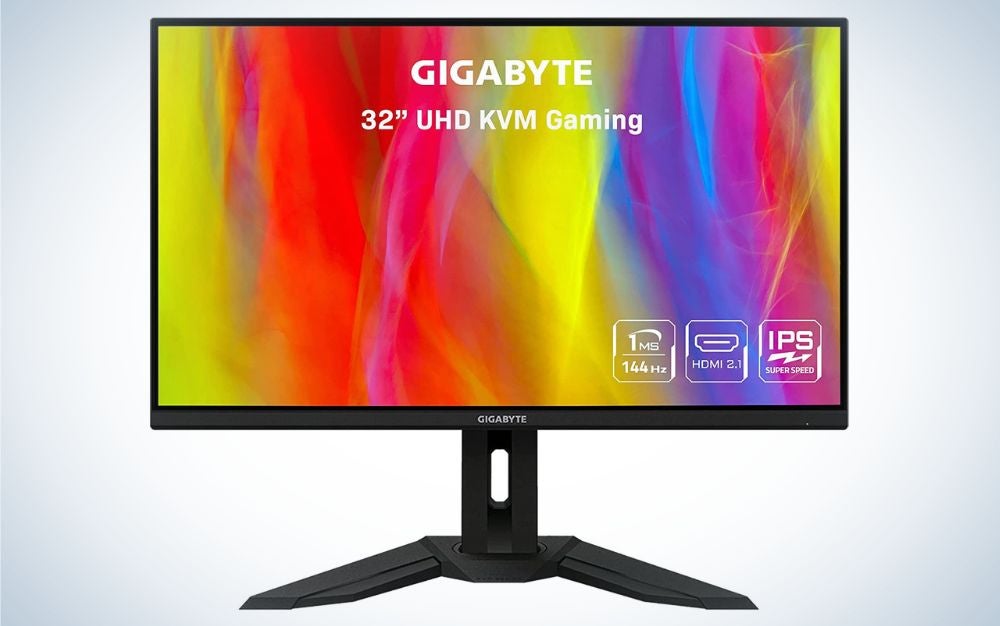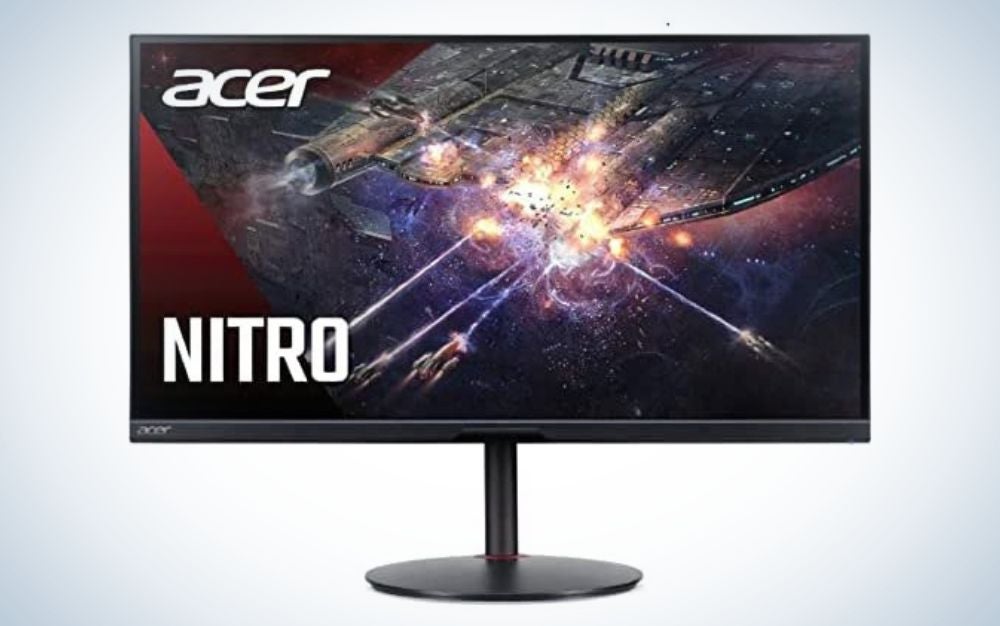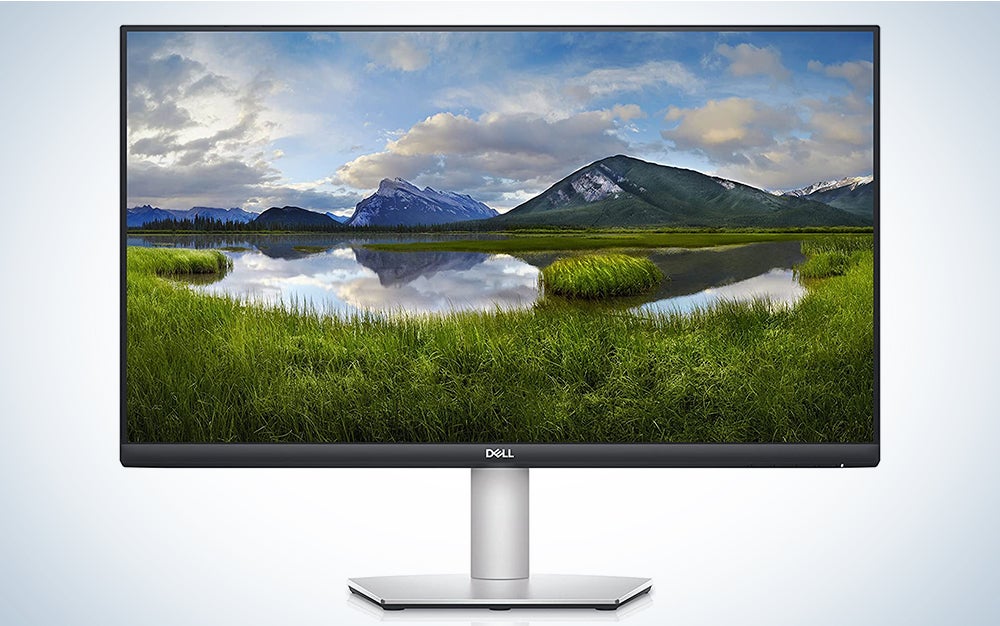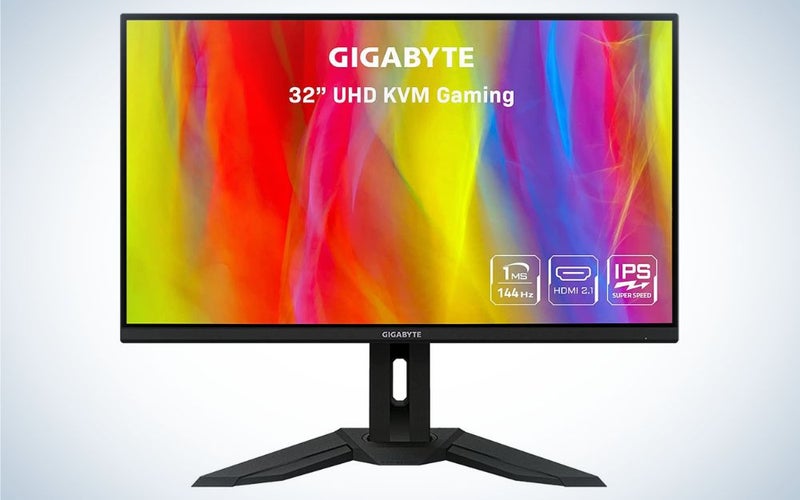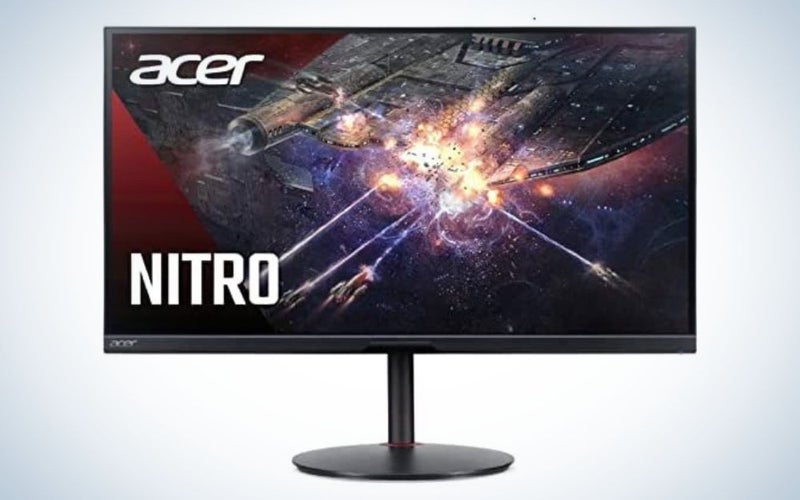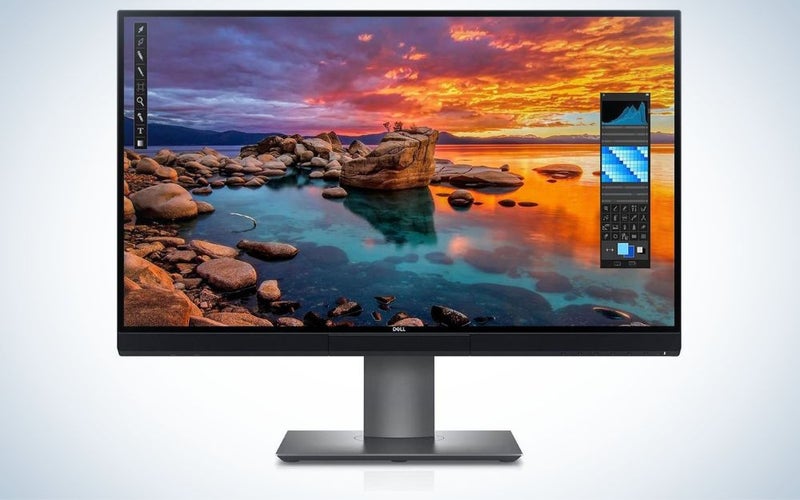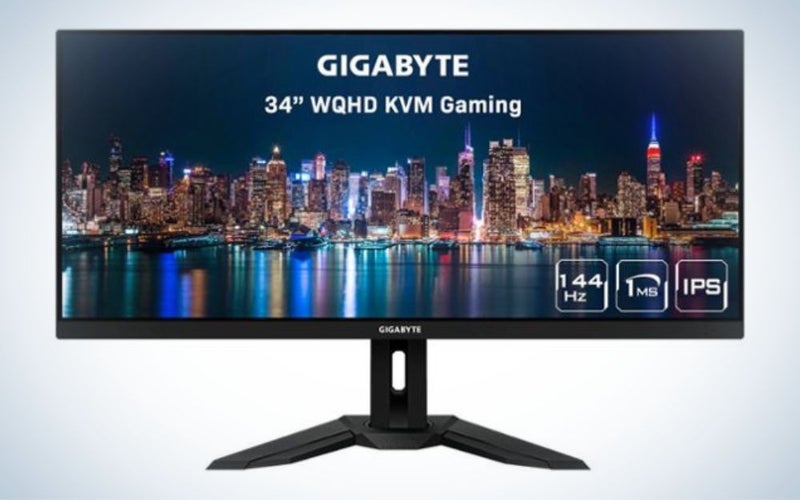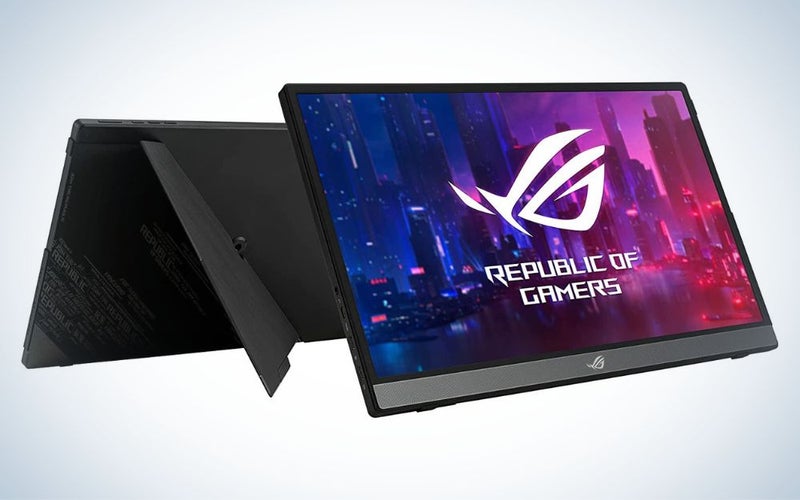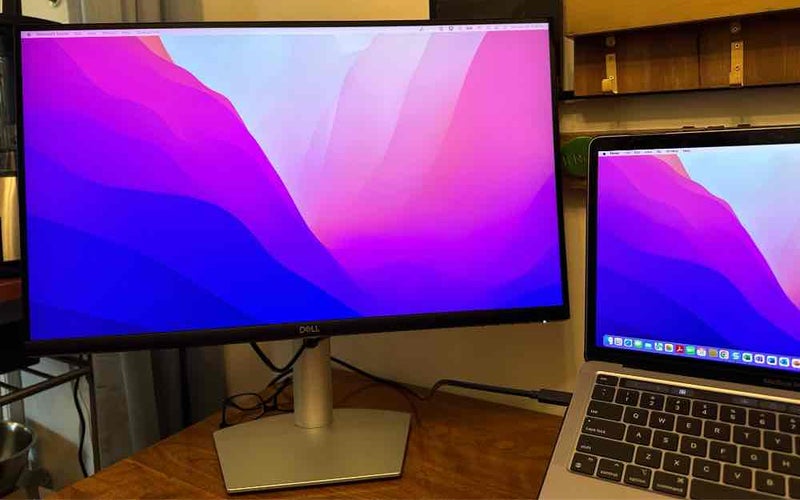We may earn revenue from the products available on this page and participate in affiliate programs. Learn more ›
Even with wireless mice and keyboards and cable ties, our desks can still turn easily into a mess of cables, and an unlikely solution may be to get a USB-C monitor. USB-C promises to help clean things up by giving you just one cable to charge all your tech. With the right setup, you can even use a USB-C cable to charge a laptop and plug it into a monitor. Who needs HDMI or DisplayPort when one cable makes everything so easy? Here’s the thing: Not every monitor with a USB-C port will get the job done. You need the right laptop and the right display. The best USB-C monitors will offer great performance while mitigating cable clutter at your work setup.
- Best overall: Gigabyte M32U
- Best gaming: Acer Nitro XV282K KVbmiipruzx
- Best for creatives: Dell UltraSharp 27 PremierColor (UP2720Q)
- Best ultrawide: Gigabyte M34WQ
- Best portable: ARZOPA Portable Monitor 2K
- Best budget: Dell S2722QC
How we chose the best USB-C monitors
I’ve been working as a tech critic for almost 10 years and have tested monitors and other computing gear for The Tech Report, TechnoBuffalo, and Popular Science. In that time, I’ve used some of the best and worst options from different brands out there.
To make our selections, we drew upon our monitor testing program, sourced opinions from critics at multiple publications and user impressions from across the internet, and leveraged our general knowledge of display technology. We looked for interesting monitors to fit a few different categories. Our picks have no price limit and displays can range anywhere from a few hundred dollars to a few thousand.
The best USB-C monitors: Reviews & Recommendations
You have the right laptop and a good Thunderbolt-certified USB cable. It’s time to pick out the best USB-C monitor for you. Whether you’re looking for an all-in-one option or something more particular, we’ve covered some of the most common use cases for which you might want to pick a monitor. All of these monitors have a USB-C port that features DP Alt Mode: Hopefully, that will spare you the time and heartache that comes from comparing too many spec sheets.
Best overall: Gigabyte M32U
Gigabyte
Buy it used or refurbished: eBay
Why it made the cut: The Gigabyte M32U has a great feature set and a fair price, making it easy to recommend.
Specs
- Size: 32-inch
- Resolution: 3840×2160 (4K)
- Panel type: IPS
- Max refresh rate: 144 Hz
- Ports: 1 x DisplayPort 1.4, 2 x HDMI 2.1 (24 Gbps), 1 x USB Type-C, 3 x USB 3.2 Gen1 Type-A
- USB Type-C power delivery: 15W
Pros
- 4K resolution
- IPS panel ensures bright colors and great viewing angles
- HDMI 2.1 ports, high refresh rate, and VRR are great for console gamers
Cons
- Contrast is not ideal on IPS screens
- Doesn’t charge your laptop while connected
Though PC component maker Gigabyte is relatively new to the monitor game, it already has found a strong foothold in the space with some truly great gaming displays. At $799, the Gigabyte M32U delivers a 4K IPS display with a maximum refresh rate of 144Hz over DisplayPort and HDMI. It’s one of only a handful of monitors right now with two HDMI 2.1 ports, making it an excellent choice for anyone plugging their PS5 or Xbox Series X into a monitor. In fact, you could connect an Xbox Series X, PlayStation 5, desktop gaming PC, and multimedia laptop to the same display, turning your desk into the ultimate tech hub.
There are some minor flaws in the formula, though. The M32U only puts out 15W of power delivery through USB-C, so it won’t charge your laptop while you’re using it. Its HDMI 2.1 connections are limited to 24 Gbps of the spec’s 48 Gbps, too, so if you use all of the HDMI 2.1 features offered by a console or graphics card with HDMI 2.1 ports, it may introduce Display Stream Compression, which can limit supported resolutions on that device.
Even keeping those in mind, this is a killer monitor for the price and a display that should last you for years easily.
Best gaming: Acer Nitro XV282K KVbmiipruzx
Acer
Buy it used or refurbished: eBay
Why it made the cut: HDMI 2.1 and a suite of gaming features make this a great monitor for any gamer.
Specs
- Size: 28-inch
- Resolution: 3840 x 2160 (4K)
- Panel type: IPS
- Max refresh rate: 144hz
- Ports: 1 x DisplayPort 1.4, 2 x HDMI 2.1, 1 x USB Type-C, 4 x USB 3.2 Gen1
- USB Type-C power delivery: 65W
Pros
- HDMI 2.1, DisplayPort, and USB-C connectivity
- IPS means great color and viewing angles
- Charges your laptop while it’s plugged in
Cons
- HDMI 2.1 ports are limited to 24 Gbps
Similar to our top pick, the Acer Nitro XV282K can serve incredible visuals for gaming, work, and everyday computing across all kinds of connections, including USB-C. This 4K, 144Hz IPS panel features DisplayPort for your desktop PC and HDMI 2.1 for consoles and recent graphics cards. It features VRR in the form of Nvidia G-Sync compatibility for most Nvidia graphics cards and AMD FreeSync Premium for AMD cards and the PlayStation 5 and Xbox Series consoles. The USB-C port offers up 65W of USB power delivery, so it can charge your laptop while you use it as a secondary display.
It also shares some of the Gigabyte M32U’s flaws—namely that its HDMI 2.1 ports on this display are limited to 24 Gbps and may compress high-resolution images when using certain niche HDMI 2.1-specific features. On the other hand, the Nitro XV282K can send up to 65W of power over USB-C, so laptop users connecting that way can keep their computers charged while using the display.
It also costs $100 more on average than the M32U at launch. You could argue that the Acer Nitro XV282K delivers the complete dream of a USB-C gaming monitor, allowing you to route an entire gaming laptop set up through a single cable. The question is, are you willing to spend an extra $100 to achieve it?
Best for creatives: Dell UltraSharp 27 PremierColor (UP2720Q)
Dell
Buy it used or refurbished: eBay
Why it made the cut: Bold, accurate 4K and a built-in colorimeter make this display a standout for creative professionals.
Specs
- Size: 27-inch
- Resolution: 3840×2160 (4K)
- Panel type: IPS
- Max refresh rate: 60 Hz
- Ports: 1 x DisplayPort 1.4, 2 x HDMI 2.0, 1 x USB Type-C Upstream (Thunderbolt 3), 1 x USB Type-C Downstream (Thunderbolt 3), 2 x USB 3.2 Gen 2, 2 x USB 3.2 Gen 1
- USB Type-C Power Delivery: 90W
Pros
- Built-in colorimeter
- 90W USB power delivery
- Tons of ports
Cons
- Very expensive
- Low brightness
Professional artists, photographers, or video editors have a separate set of priorities when picking out a monitor for creating their work. Everyone wants a bold, beautiful monitor with vibrant colors, but creatives need the fullest, most accurate colors possible. That pursuit may lead them to consider a specialized display like the Dell UltraSharp 27 PremierColor, which is made—and priced—for professionals. This 27-inch IPS panel covers 100% Adobe RGB and 98% DCI-P3 Wide Color Gamut for incredibly deep and reliable color. Unlike most creative monitors, it features a built-in colorimeter, a piece of equipment you normally purchase separately to help you maintain that high color accuracy. Having it built in means you can schedule regular calibrations to run while you’re away and check the results when you’re ready to work.
Like many other creative screens, the UltraSharp 27 PremierColor has a shading hood to block out glare and reflections. It also offers picture-in-picture, allowing you to view the same image in different color spaces or compare images from two different sources. Even better, it features two Thunderbolt 3-certified USB Type-C ports with 90W power delivery, allowing you to plug in two laptops, charging both while you compare and contrast.
At well over $1,000, this is an expensive piece of professional equipment made for people who need to achieve this high standard. If you’re one of those people, this is one of the best options out there.
Best ultrawide: Gigabyte M34WQ
Gigabyte
Buy it used or refurbished: eBay
Why it made the cut: There aren’t a ton of ultrawide displays out there with USB-C connectivity, and the Gigabyte M34WQ is affordable and solid.
Specs
- Size: 34-inch
- Resolution: 3440×1440 (21:9)
- Panel type: IPS
- Max refresh rate: 144 Hz
- Ports: 1 x DisplayPort 1.4, 2 x HDMI 2.0, 1 x USB Type-C, 2 x USB 3.2 Gen1 Type-A
- USB Type-C power delivery: 15W
Pros
- High refresh rate and low input lag
- FreeSync Premium support
- Vibrant color even at sharp angles
Cons
- IPS contrast is somewhat limited
If “ultrawide” and “USB Type-C” are both on your monitor checklist, Gigabyte’s M34WQ should be your go-to option. There aren’t too many options combining the two niche categories, and Gigabyte’s option stands out for its performance and price.
The $500-on-average M34WQ features a strong set of gaming features and lots of ports. The IPS display means vivid colors, and the screen offers an above-average 400 nits brightness to back that up. That also means limited contrast, with blacks looking closer to grays in a dark room as with any other IPS display.
With DisplayPort and HDMI options, as well as two USB Type-A ports and, of course, the required USB-C port, you can plug a ton of stuff into this screen to make it the center of your desktop. On the other hand, its USB-C connection only delivers 15W of power … so it won’t charge your laptop. Likewise, the screen technically supports HDR, but it’s VESA DisplayHDR 400, so it doesn’t guarantee a tangible difference in games.
Like our best overall and budget screens, this is more of a generalist’s screen, albeit with a high refresh rate for gaming. It will serve its purpose well no matter how you use it.
Best portable: ARZOPA Portable Monitor 2K
ASUS
Buy it used or refurbished: eBay
Why it made the cut: Arzopa’s portable display has better specs than its modest price would suggest.
Specs
- Size: 13.3-inch
- Resolution: 2560 x 1600
- Panel type: IPS
- Max refresh rate: 60 Hz
- Ports: 1 x DP Alt/Charging USB Type-C, 1 x Charging USB Type-C, 1 x Micro HDMI
- USB Type-C power delivery: 0W
Pros
- Thin design
- High-resolution screen
- Multiple inputs
Cons
- Both USB-C ports are on one side
If you want a USB-C monitor to take on the road, Arzopa’s 13.3-inch 1440p screen is the ideal second screen. The display’s resolution and size are identical to Apple’s 13-Inch MacBook Pro (pictured above), which makes them a particularly good pair. During my tests we found text, video, and photos looked crisp and clear on this monitor, though I recommend immediately enabling the display’s HDR mode for the most accurate color reproduction. This mode isn’t on by default, but can be toggled easily in the display’s settings.
Every workflow is different, but our tests, which included using the display as a dedicated screen for research or editing photos, to be beneficial to our productivity. Anyone who’s used to working on a 13.3-inch laptop will immediately feel comfortable using this portable USB-C monitor because they’ll already know how many apps they can reasonably fit on the screen without feeling overwhelmed.
Arzopa’s portable has a pair of USB-C ports and one Mini HDMI port, which allows you to connect multiple devices to it at the same time. The company includes both a USB-C cable and Mini HDMI cord, so it’s ready to connect immediately. Our only complaint with the portable USB-C monitor’s design is that both USB-C ports are located on one side. In our tests, this required us to snake a cable around the back of our MacBook Pro to plug it in. Having one USB-C port per side would have made connecting to this monitor a little easier.
Overall, we found this monitor to be simple to setup and use. Our computer connected to it immediately, and we were able to make adjustments to its resolution and orientation within MacOS’ Display Settings app. A little switch on the monitor itself allowed us to change its brightness, contrast, and enable the aforementioned HDR setting. It took roughly five minutes to complete the monitor’s setup process, and hooking it up took only seconds.
A majority of 13.3-inch portable USB-C monitors have a 1080P screen, so the extra resolution on Arzopa’s 2K display makes a noticeable difference. The ability to see additional information on the display is reason enough to upgrade if you have a lower-resolution portable USB-C display, and a great entry point if you don’t.
Best budget: Dell S2722QC
Brandt Ranj
Why it made the cut: The Dell S2722QC is a great 4K monitor for a laptop-centric work-from-home setup.
Specs
- Size: 27-inch
- Resolution: 3840×2160 (4K)
- Panel type: VA LCD
- Max refresh rate: 60Hz
- Ports: 2 x HDMI 2.0, 1 x USB Type-C, 2 x USB-A, 1 x headphone jack
- USB Type-C power delivery: 65W
Pros
- 65W of USB Type-C Power Delivery means you can charge your laptop while you use it
- Sturdy Stand
- Rotation and height adjustment
Cons
- Response rate too low for gaming
Dell’s S2722QC makes the dream of USB-C monitors a reality for many more people because of its low price point—the display’s cost fluctuates, but it’s possible to pick one up for under $300. The most surprising feature of this monitor is its overall build quality. Yes, Dell used plastic, but its stand and foot feel sturdy. This was true even when rotating the display 90 degrees or adjusting its height. Those ergonomic features made it possible to position the display at just the right spot to avoid neck strain.
This monitor’s USB-C port is the star of the show—our 13-inch MacBook Pro never had a problem connecting or charging—but it’s complemented by a pair of HDMI ports, two USB-A ports, and a headphone jack. Those USB-A ports come in handy if you want to connect a webcam and external hard drive to your machine when you plug your laptop into this display.
Overall, we were pleased with the performance of Dell’s S2722QC during common tasks like reading articles, streaming video, and being a part of digital meetings. The display’s color accuracy was good enough for casual photo editing, but professionals are better off with a display that covers 100% of the sRGB color spectrum. On the other hand, the monitor’s 4K resolution made those photos, videos, and text look sharp.
If anything, our time with the Dell S2722QC shows just how far USB-C monitors have come in the past couple of years. To get this level of performance from a display that’s this inexpensive is remarkable and proves the company’s commitment to pushing premium features in less expensive hardware.
Things to consider before buying one of the best USB-C monitors
USB Type-C—or, casually, USB-C—can get more complicated than you might expect if you’re using it for anything other than charging. While it was conceived as a universal cable, there are multiple versions of the technology that dictate how it can be used, which vary from device to device. On top of that, using USB-C to link a PC to a monitor requires certain technology in your computer. In other words, picking a USB-C monitor isn’t as easy as checking whether your display has a USB-C port.
Once you figure out which monitors suit your connectivity needs and which do not, you still have to pick one! That means wading through specs that may immediately make sense to the average PC user, including resolution, refresh rate, color accuracy, and panel type. We will focus on the specifics of picking a USB-C monitor here because it is complicated. Still, we recommend checking out some of our other monitor explainers (best ultrawide monitors, best 240hz monitors, and best monitors for color grading), where you can read thorough but efficient descriptions of the core specs that will help you pick a fantastic monitor for yourself.
Before we start: Does your PC support DisplayPort Alternate Mode?
Not all USB-C connections are created equal. In 2022, there were three versions of USB-C, or five if you include the physically identical but more feature-rich Thunderbolt 3 and Thunderbolt 4 connections. The more fully featured the port, the more expensive it is to manufacture, and USB-C ports that effectively transfer enough data to support a display are on the pricey side. As such, you’ll need to keep a sharp eye out and ensure that your PC and monitor have the ports you need.
To connect your PC to a USB-C monitor, the computer must support a software feature called DisplayPort Alternate Mode, or DP Alt, which allows you to use your USB-C port as a DisplayPort output, transmitting video at full bandwidth. Here’s the tricky part: Not all USB-C ports support DP Alt mode; it is an optional feature that manufacturers can add if they want. There are easy ways to check whether your laptop has USB-C ports with DP Alt Mode, but you may be forced to check the specs for your laptop.
That said, there are a few visual markers that may quickly indicate if a specific USB-C port can be used to connect to a USB-C monitor.

A “DP” DisplayPort logo placed next to a USB-C port means explicitly the port supports DisplayPort Alternate Mode. More broadly, the lightning bolt icon indicates that the USB-C port supports Thunderbolt 3 or 4. Thunderbolt is a more feature-rich version of USB-C and guarantees support for DP Alt Mode. It’s important to recognize these two, specifically, because there are also symbols that do not tell you whether your USB-C port can connect to a monitor: The USB SuperSpeed logo, for example, refers to the connection’s maximum bandwidth. (USB, as it turns out, is extremely complicated.)
So what laptops support DisplayPort Alternate Mode? Most modern Apple laptops should, including MacBook Pros made in 2016 or later and MacBook Air models released after 2017. Among Windows laptops, there is no hard and fast rule. You can specifically check spec sheets for DisplayPort Alternate Mode, check the laptop for either the Thunderbolt 3 or DisplayPort Alternate Mode logos.
There isn’t really a standard for how this is handled, unfortunately, so it may require some sleuthing. For example, the Dell XPS 13 Ultrabook doesn’t feature the markings to accommodate its more sleek look, and the spec sheet just says “2 Thunderbolt 4 ports.” Lenovo’s ThinkPad X1 Yoga features two USB ports that show the lightning bolt icon, and the spec sheet explicitly says “2 x USB-C Thunderbolt 3 (Power Delivery, DisplayPort).” Both laptops support the mode but label it differently.
Video over USB-C support
Once you’ve confirmed that your PC can connect to a monitor over USB-C, it’s important to ensure the monitor you pick out can do the same. Not every display that has USB-C ports can transmit video that way. To ensure a display supports video over USB-C, check the display’s specs for a Thunderbolt 3 port or higher, supports DP Alt mode, or lists USB-C as a supported video connection.
All the monitors on this list can transmit video over USB-C, so all of our picks will set you up for success.
You need the right cable, too …
We had to talk about the port on your laptop, and we had to talk about the port on your monitor. Why wouldn’t we also have to talk about the cable that runs between them? Connecting a PC and monitor is, unfortunately, not as simple as just grabbing the nearest Type-C cable out of your drawer and plugging it in. (We know you have one, but some of those chargers are 10 years old and you don’t even remember what they’re for, so get rid of them!)
Like the ports, there are many kinds of USB-C cables, and some are intentionally created on the cheap. The cable that will most likely come with your monitor will work fine. If, for some reason, you need to pick another, look for a Thunderbolt-certified USB Type-C cable to make sure that you’re getting something reputable and safe.
Can it charge, though?
One of the primary benefits of connecting a laptop to a monitor over USB-C is the promise that your monitor will be able to charge, or at least power, your computer while it’s plugged in. As it turns out, though, this feature is a niche within a niche. A monitor may be able to charge or power a laptop, depending on how many Watts (W) it delivers to power-hungry devices and how much power your laptop uses. Between those two factors, a simple question gets pretty complicated; even official explainers like this one from PC accessory company Belkin can be pretty vague.
Laptops typically require between 20W of charging power for a thin productivity laptop to upwards of 100W for gaming laptops with large graphics cards. Right now, the highest wattages offered on monitors with USB-C ports are 65W and 90W, which should be enough to charge most compatible laptops. Many monitors, however, feature 15W charging, enough to extend your laptop’s battery life a bit if it’s running while you’re plugged in. A 15W connection is enough to charge a phone, tablet, or any other small device you might want to plug in.
We hope that, a few years from now, this will get much simpler. At the very least, we hope manufacturers standardize how monitor-grade USB-C connections work. For now, though, it requires a fair amount of research to predict the compatibility of a specific laptop and USB-C monitor.
FAQs
Q: Is it worth buying a USB-C monitor?
That’s a good question! A USB-C connection simplifies plugging a laptop into a monitor and, in some cases, can power any laptop plugged in that way. On the other hand, finding a laptop and monitor supporting such a connection can be painstaking and expensive.
If you are building a home office or gaming battlestation built around a laptop, using a USB-C monitor can clean up your desk’s cable clutter while making the laptop much more portable when you have to get up and go. Just one cable to unplug, and you’re on your way. You’re probably better off sticking with DisplayPort for desktops and “desktop replacement”-style gaming laptops, however.
Q: Can USB Type-C do 144Hz/4K/etc.?
If your display’s USB Type-C port supports DP Alt Mode, the connection will allow for the monitor’s maximum refresh rate and resolution. Our picks output at 4K and/or 144Hz via USB-C.
Q: Can USB-C support dual monitors?
Some, but not all, USB-C monitors allow you to connect multiple displays using that connection. You’ll want to consult your PC’s manual and manufacturer to determine whether you can and how it will work with your specific display. For example, Apple says you can connect a display to both MacBook Pro USB-C ports. With Windows PCs, some displays allow you to “daisy chain” USB-C monitors, plugging your PC into one monitor, then connecting a second monitor to the first.
If you want to use multiple monitors but don’t care specifically about using a specific type of port, you can always connect one monitor via USB-C and another via DisplayPort, HDMI, or any other connections you have on your PC and monitor.
Q: How much do USB-C monitors cost?
This depends on its size, resolution, ports, and other features. You can spend as little as $299.99 or as much as $1,298.
Final thoughts on the best USB-C monitors
- Best overall: Gigabyte M32U
- Best gaming: Acer Nitro XV282K KVbmiipruzx
- Best for creatives: Dell UltraSharp 27 PremierColor (UP2720Q)
- Best ultrawide: Gigabyte M34WQ
- Best portable: ARZOPA Portable Monitor 2K
- Best budget: Dell S2722QC
Finding a great monitor that fits the bill can become difficult as your needs get more specific. Finding a monitor with a USB-C port isn’t too tough, but finding one with a USB-C port that supports DP Alt Mode and delivers enough power to charge a laptop limits you to a pretty small group of displays. It’s so small, in fact, that we’re not quite ready to make 65W a prerequisite for making our list. Add to that the fact that you need to check your laptop to make sure it’s compatible, and picking a USB-C monitor becomes a fairly complicated task. Search for information about your particular laptop and USB Type-C before splurging on one of the best USB-C monitors, but if you have the right setup, plugging your monitor in this way will make your workspace more convenient and flexible.
Why trust us
Popular Science started writing about technology more than 150 years ago. There was no such thing as “gadget writing” when we published our first issue in 1872, but if there was, our mission to demystify the world of innovation for everyday readers means we would have been all over it. Here in the present, PopSci is fully committed to helping readers navigate the increasingly intimidating array of devices on the market right now.
Our writers and editors have combined decades of experience covering and reviewing consumer electronics. We each have our own obsessive specialties—from high-end audio to video games to cameras and beyond—but when we’re reviewing devices outside of our immediate wheelhouses, we do our best to seek out trustworthy voices and opinions to help guide people to the very best recommendations. We know we don’t know everything, but we’re excited to live through the analysis paralysis that internet shopping can spur so readers don’t have to.
